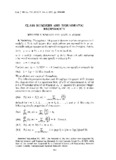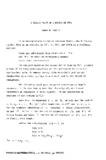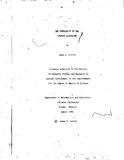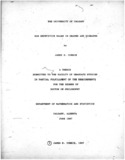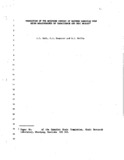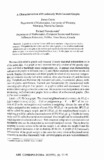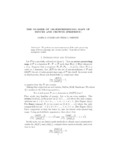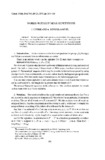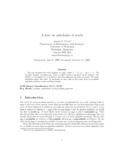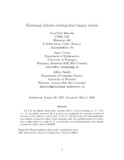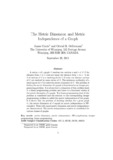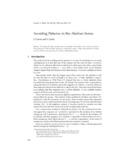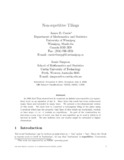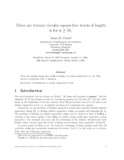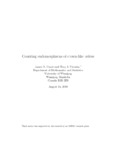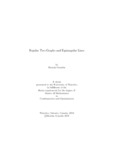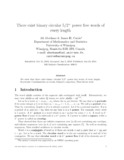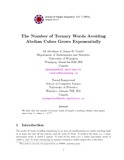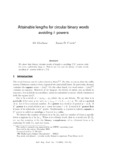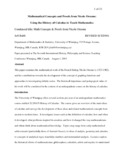Browsing Department of Mathematics and Statistics by Issue Date
Now showing items 1-20 of 73
-
Class Numbers and Biquadratic Reciprocity
(Cambridge University Press, 1982) -
A direct proof of a result of Thue
(Utilitas Mathematica, 1984) -
The Complexity of the Simplex Algorithm
(Carleton UniversityCarleton University, 1984-08)The thesis begins by giving background in linear programming and Simplex methods. Topics covered include the duality theorem, Lemke's algorithm, and the pathological programs of Klee-Minty. Because of the bad behaviour ... -
Non repetitive walks in graphs and digraphs
(The University of CalgaryUniversity of Calgary, 1987-06)A word $w$ over alphabet $\Sigma$ is {\em non-repetitive} if we cannot write $w=abbc$, $a,b,c\in\Sigma^*$, $b\ne\epsilon$. That is, no subword of $w$ appears twice in a row in $w$. In 1906, Axel Thue, the Norwegian number ... -
Prediction of the Moisture Content of Eastern Canadian Corn using Measurements of Capacitance and Test Weight
(NRC Research Press, 1989-01)A statistical regression model for rapid prediction of moisture content based on measurements of dielectric capacitance and test weight was developed for Eastern Canadian corn (Zea mays L.). For 336 samples of the 1986 ... -
A Characterization of Fractionally Well-Covered Graphs
(Ars Combinatoria, 1991)A graph is called well-covered if every maximal independent set has the same size. One generalization of independent sets in graphs is that of a fractional cover -- attach nonnegative weights to the vertices and require ... -
The number of order–preserving maps of fences and crowns
(Springer, 1991-06)We perform an exact enumeration of the order-preserving maps of fences (zig-zags) and crowns (cycles). From this we derive asymptotic results. -
Words without Near-Repetitions
(Canadian Mathematical Society, 1992-06-01)We find an infinite word w on four symbols with the following property: Two occurrences of any block in w must be separated by more than the length of the block. That is, in any subword of w of the form xyx, the length of ... -
A Note on Antichains of Words
(The Electronic Journal of Combinatorics, 1995-10-14)We can compress the word 'banana' as xyyz, where x= 'b', y= 'an',z= 'a'. We say that 'banana' encounters yy. Thus a 'coded' version of yy shows up in 'banana'. The relation 'u encounters w' is transitive, and thus generates ... -
Extremal Infinite Overlap-Free Binary Words
(The Electronic Journal of Combinatorics, 1998-05-03)Let t be the infinite fixed point, starting with 1, of the morphism μ:0→01, 1→10. An infinite word over {0,1} is said to be overlap-free if it contains no factor of the form axaxa, where a∈{0,1} and x∈{0,1}∗. We prove that ... -
The metric dimension and metric independence of a graph
(The Charles Babbage Research Centre, 2001)A vertex x of a graph G resolves two vertices u and v of G if the distance from x to u does not equal the distance from x to v. A set S of vertices of G is a resolving set for G if every two distinct vertices of G are ... -
Avoiding Patterns in the Abelian Sense
(Canadian Mathematical Society, 2001-08)We classify all 3 letter patterns that are avoidable in the abelian sense. A short list of four letter patterns for which abelian avoidance is undecided is given. Using a generalization of Zimin words we deduce some ... -
Non-Repetitive Tilings
(The Electronic Journal of Combinatorics, 2002-07-03)In 1906 Axel Thue showed how to construct an infinite non-repetitive (or square-free) word on an alphabet of size 3. Since then this result has been rediscovered many times and extended in many ways. We present a two-dimensional ... -
There are Ternary Circular Square-Free Words of Length n for n ≥ 18
(The Electronic Journal of Combinatorics, 2002-10-11)There are circular square-free words of length n on three symbols for n≥18. This proves a conjecture of R. J. Simpson. -
Counting endomorphisms of crown-like orders
(Springer, 2002-12)The authors introduce the notion of crown-like orders and introduce powerful tools for counting the endomorphisms of orders of this type. -
Regular Two-Graphs and Equiangular Lines
(University of WinnipegUniversity of Waterloo, 2004)Regular two-graphs are antipodal distance-regular double coverings of the complete graph, and they have many interesting combinatorial properties. We derive a construction for regular two-graphs containing cliques of ... -
There Exist Binary Circular 5/2+ Power Free Words of Every Length
(The Electronic Journal of Combinatorics, 2004-01-23)We show that there exist binary circular 5/2+ power free words of every length. -
The Number of Ternary Words Avoiding Abelian Cubes Grows Exponentially
(2004-06-19)We show that the number of ternary words of length n avoiding abelian cubes grows faster than r^n, where r = 2^{1/24} -
Attainable lengths for circular binary words avoiding k-powers
(The Belgian Mathematical Society, 2005)We show that binary circular words of length n avoiding 7/3+ powers exist for every sufficiently large n. This is not the case for binary circular words avoiding k+ powers with k < 7/3 -
Mathematical Concepts and Proofs from Nicole Oresme: Using the History of Calculus to Teach Mathematics
(2005)This paper examines the mathematical work of the French bishop, Nicole Oresme (c. 1323–1382), and his contributions towards the development of the concept of graphing functions and approaches to investigating infinite ...

